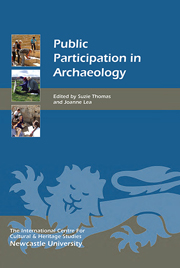Book contents
- Frontmatter
- Dedication
- Contents
- List of Illustrations
- Acknowledgments
- List of Abbreviations
- Preface
- Introduction
- Public Participation in Archaeology: International Models
- 1 From ‘Telling’ to ‘Consulting’: A Perspective on Museums and Modes of Public Engagement
- 2 Making Archaeological Heritage Accessible in Great Britain: Enter Community Archaeology
- 3 Public and Community Archaeology — an Irish Perspective
- 4 The Scope and Potential for Community Archaeology in the Netherlands
- 5 Public Archaeology as a Reflexive Practice: An Argentine Case Study in the Pampean Region
- Public Participation in Archaeology Through Education
- Public Participation in Archaeology Through Tourism
- Public Participation in Archaeology Through Site Management and conservation
- List of Contributors
- Index
2 - Making Archaeological Heritage Accessible in Great Britain: Enter Community Archaeology
from Public Participation in Archaeology: International Models
Published online by Cambridge University Press: 05 August 2014
- Frontmatter
- Dedication
- Contents
- List of Illustrations
- Acknowledgments
- List of Abbreviations
- Preface
- Introduction
- Public Participation in Archaeology: International Models
- 1 From ‘Telling’ to ‘Consulting’: A Perspective on Museums and Modes of Public Engagement
- 2 Making Archaeological Heritage Accessible in Great Britain: Enter Community Archaeology
- 3 Public and Community Archaeology — an Irish Perspective
- 4 The Scope and Potential for Community Archaeology in the Netherlands
- 5 Public Archaeology as a Reflexive Practice: An Argentine Case Study in the Pampean Region
- Public Participation in Archaeology Through Education
- Public Participation in Archaeology Through Tourism
- Public Participation in Archaeology Through Site Management and conservation
- List of Contributors
- Index
Summary
Introduction
This chapter provides an overview of the way in which archaeology has been presented, interpreted and made available to the wider public in Great Britain — England, Scotland and Wales — over the past few years. The chapter begins by examining briefly the phenomenon of ‘community archaeology’ in Great Britain; a term which in recent decades has, arguably, become synonymous with public participation in British archaeological heritage. What this means in the British context is explored below. Some examples are given of participation, both community-led and organisation-initiated; recent changes to the landscape of archaeology in Great Britain are presented, and the challenges as well as opportunities that lie ahead are discussed.
‘Community Archaeology’: What Does This Mean Exactly?
Community archaeology seems first to have emerged as a term in the 1970s with the pioneering work of Peter Liddle, still actively supporting community archaeology in Leicestershire since that time and widely regarded as a key founder of community archaeology as a movement. There are parallels in its evolution to be found with discussions of the related term ‘public archaeology’ initiated in the USA, also in the 1970s (McGimsey 1972); this term is still popular and, as noted elsewhere, is even the namesake for an international journal (Smith and Waterton 2009, 16).
The actual definition of ‘community archaeology’ has been at times problematic to capture. Such definitions as do exist are fairly broad. Corbishley (2011, 104) offers that: ‘community archaeology is the term most often used to describe any outreach aspect of an archaeological project but it can mean a number of different types of project and involve a range of “publics”‘.
- Type
- Chapter
- Information
- Public Participation in Archaeology , pp. 23 - 34Publisher: Boydell & BrewerPrint publication year: 2014



